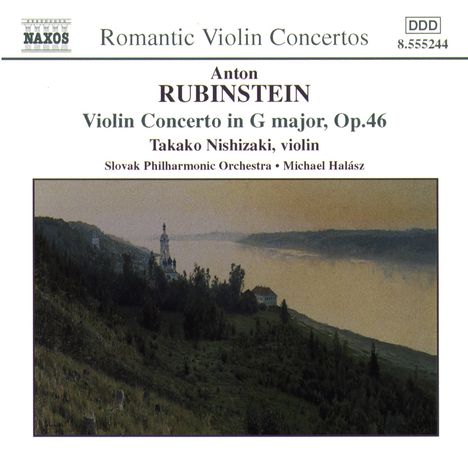Anton Rubinstein: Violinkonzert G-dur op.46 auf CD
Violinkonzert G-dur op.46
Herkömmliche CD, die mit allen CD-Playern und Computerlaufwerken, aber auch mit den meisten SACD- oder Multiplayern abspielbar ist.
Lassen Sie sich über unseren eCourier benachrichtigen, falls das Produkt bestellt werden kann.
+Cui: Suite concertante op. 25
- Künstler:
- Takako Nishizaki, Slowak Philharmonic Orchestra, Michael Halasz; Hong Kong Philharmonic Orchestra, Kenneth Schermerhorn
- Label:
- Naxos
- Aufnahmejahr ca.:
- 1985
- UPC/EAN:
- 0747313524426
- Erscheinungstermin:
- 19.3.2001
Ähnliche Artikel
Das Violinkonzert in G-Dur, Opus 46, geschrieben 1857, als Rubinstein 28 Jahre alt war, wird zu Unrecht vernachlässigt. Das Werk hat nichts besonders Russisches an sich, es zeigt das feine handwerkliche Können eines Mendelssohns und eine zweifellos professionelle technische Beherrschung von Struktur und Orchestrierung. Die drei Sätze des Konzerts bieten eine bewundernswerte Gelegenheit für eine virtuose Darbietung. Der erste Satz beginnt mit einer Orchestereinleitung, die auf dem Hauptthema des Satzes basiert, vor dem dramatischen Einstieg des Solisten, der später das Hauptthema aufgreift, gefolgt von einem Passagenwerk und mehr lyrischem Material, das mit dem Orchester entwickelt wird, mit kurzen Kadenzen und abschließender Aufregung. Der langsame Satz beginnt mit einem hymnischen Orchesterthema und einem Trompetensolo, bevor der Solist in hoher Lage eintritt, um das Material zärtlich lyrisch zu kommentieren, bevor er zu Musik von größerer Intensität übergeht. Die Heiterkeit des Schlusses des Satzes wird sofort durch das folgende, lebhafte Finale mit kontrastierendem thematischem Material unterbrochen, das dennoch Momente der Entspannung und der Schlussdramatik bringt.
Die Suite Concertante von Cui wurde 1884 geschrieben und später von Beljajew veröffentlicht. Das Werk existiert auch in einer Version für Violine und Klavier. Das erste Intermezzo-Scherzando beginnt mit einer kurzen Einleitung vor dem Auftritt der Solovioline in russischer Stimmung, das Tanzthema wird später mit dem Orchester geteilt. Der Satz entspannt sich in einem Trio-Abschnitt mit mehr lyrischem Gefühl, der durch die Rückkehr des kräftigen Rhythmus der Eröffnung ersetzt wird und sich in seinem Schlussteil kurzzeitig in einen sanften Walzer verwandelt. Der zweite Satz, eine Canzonetta, beginnt mit einer anmutigen Violinenmelodie, einem Material, das einen zentralen Abschnitt mit kontrastierender Energie umrahmt. Für den dritten Satz leiht Cui wiederum einen Titel aus der Vokalmusik. Die Cavatina, eingeführt von den Holzbläsern, erlaubt der Violine eine romantische Melodie, eine Umsetzung der zeitgenössischen Oper in instrumentale Begriffe. Die Suite endet mit einer Tarantella, einem neapolitanischen Tanz, der im 19. Jahrhundert instrumentale Popularität erlangte und dessen Ursprung in einer angeblichen Perpetuum-mobile-Kur gegen die Auswirkungen des Bisses der Tarantel-Spinne liegt. Hier werden die wilderen Aspekte des Tarantismus zugunsten einer respektableren Zurschaustellung rustikaler Virtuosität vermieden.
Product Information
The Violin Concerto in G major, Opus 46, written in 1857, when Rubinstein was 28, is unjustly neglected. There is nothing particularly Russian about the work, which shows the fine craftsmanship of a Mendelssohn and an undoubtedly professional technical command of structure and orchestration. The three movements of the concerto provide an admirable opportunity for virtuoso performance. The first of these opens with an orchestral introduction based on the main theme of the movement, before the dramatic entry of the soloist, who later takes up the principal theme, followed by passage-work and more lyrical material, developed with the orchestra, with brief cadenzas and final excitement. The slow movement opens with a hymn-like orchestral theme and trumpet solo before the entry of the soloist in a high register, going on to tenderly lyrical comment on the material, before moving on to music of greater intensity. The serenity of the close of the movement is broken at once by what follows, a lively finale, with contrasting thematic material that nevertheless brings moments of relaxation and final drama.
Cui's Suite Concertante was written in 1884 and later published by Belyayev. The work exists also in aversion for violin and piano. The initial lntermezzo scherzando opens with a brief introduction before the entry of the solo violin in Russian mood, the dance theme later shared with the orchestra. The movement relaxes in a trio section of more lyrical feeling, to be replaced by the return of the vigorous rhythm of the opening, turning momentarily to a gentle waltz in its closing section. The second movement, a Canzonetta, starts with a graceful violin melody, material that frames a central section of contrasting energy. For the third Cui again borrows a title from vocal music. The Cavatina, introduced by the woodwind, allows the violin a romantic melody, a transposition of the contemporary operatic into instrumental terms. The suite ends with a Tarantella, a Neapolitan dance that acquired instrumental popularity in the nineteenth century, its origin in a supposed perpetuum mobile cure for the effects of the bite of the tarantula spider. Here the wilder aspects of tarantism are avoided, in favour of a more respectable display of rustic virtuosity.
Disk 1 von 1 (CD)
-
1 Violin Concerto in G major, Op. 46: I. Moderato assai
-
2 Violin Concerto in G major, Op. 46: II. Andante
-
3 Violin Concerto In G Major, Op. 46: Iii. Moderato Assai
-
4 Suite Concertante, Op. 25: I. Intermezzo scherzando
-
5 Suite Concertante, Op. 25: II. Canzonetta
-
6 Suite Concertante, Op. 25: Iii. Cavatina
-
7 Suite Concertante, Op. 25: IV. Finale: Tarantella
Mehr von Anton Rubinstein
-
Anton RubinsteinStreichquartette Vol.1CDVorheriger Preis EUR 14,99, reduziert um 0%Aktueller Preis: EUR 7,99
-
Anton RubinsteinKlavierkonzerte Nr.2 & 4CDVorheriger Preis EUR 17,99, reduziert um 0%Aktueller Preis: EUR 7,99
-
Anton RubinsteinStreichquartette Vol.2CDVorheriger Preis EUR 14,99, reduziert um 0%Aktueller Preis: EUR 7,99
-
Anton RubinsteinKlavierquartette F-Dur op.55b & C-Dur op.66CDVorheriger Preis EUR 19,99, reduziert um 0%Aktueller Preis: EUR 9,99









